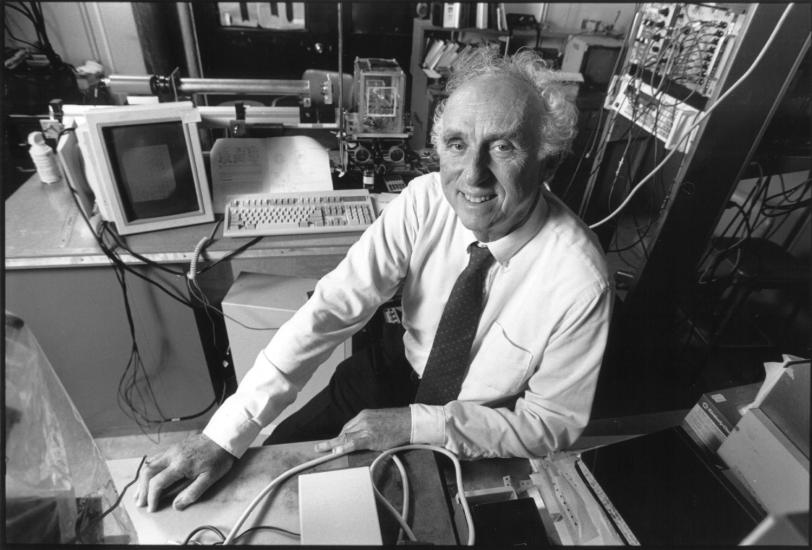Martin L. Perl, Winner of 1995 Nobel Prize for Discovery of Tau Lepton, Dead at 87
Martin L. Perl, a professor emeritus of physics at Stanford University and SLAC National Accelerator Laboratory and winner of the 1995 Nobel Prize in physics for discovery of the tau lepton, died Sept. 30 at Stanford Hospital in Palo Alto at the age of 87.
Martin L. Perl, a professor emeritus of physics at Stanford University and SLAC National Accelerator Laboratory and winner of the 1995 Nobel Prize in physics for discovery of the tau lepton, died Sept. 30 at Stanford Hospital in Palo Alto at the age of 87.
An elementary particle physicist, Perl was widely admired for his persistence and fortitude as a scientist. When he began the series of experiments that would lead to the Nobel Prize, the Standard Model that describes the fundamental particles and forces seemed to be complete, with matter divided into two classes: quarks and leptons. For many years Perl maintained there was no good reason for there to be two families of leptons, rather than three or even four; and when the SLAC linear accelerator turned on in the early 1960s, he immediately attempted to find a third family. It failed, but he did not give up. In a new series of experiments from 1974 to 1977 with a machine that could detect much shorter-lived particles, he and his colleagues finally discovered the first member of the third lepton family – the tau lepton, with 3,500 times the mass of its cousin the electron – in collisions between electrons and positrons, their antimatter opposites.
“People wanted me to be cautious,” Perl recalled in a 2013 interview. “We kept taking data and the evidence kept coming in. Every month or so we would get another handful – 10 to 20 – of these funny (particle collision) events. I gave a lot of talks. There would be all sorts of objections. I would take it all down. Some I had direct answers for, and if not, I went back and looked. We eventually eliminated every other explanation. Eventually most of the collaboration, about 30 people, became convinced there was no other explanation. And we published. Eventually other people began to find them, too.”
Said SLAC Director Emeritus and Nobelist Burton Richter, “Martin had strong views on what were the important questions in physics that experiments could answer. He picked great areas for research, as exemplified by his Nobel Prize.”
SLAC Director Chi-Chang Kao said, “Martin was a member of the SLAC and Stanford communities for 50 years, and his research greatly advanced the field of particle physics. On the personal side, Martin was a wonderful colleague, and it was a privilege to know him. His love for scientific discovery never diminished, and neither did his affection for SLAC and all who work here. One would frequently find Martin in the SLAC cafeteria at lunchtime, inviting staff to sit and talk with him. His enthusiasm was as infectious as his smile."
Born in 1927 in New York City, the son of immigrants who fled poverty and anti-Semitism in the Polish area of Russia, Perl was an avid reader who excelled at his studies and graduated high school at the age of 16. His college studies were interrupted by Merchant Marine and military service during World War II, but he returned to earn a bachelor’s degree in chemical engineering from Polytechnic Institute of Brooklyn in 1948. He worked as a chemical engineer at General Electric and, with the encouragement of his wife, Teri, went back to school at 23 to study physics, earning a PhD from Columbia University under physics Nobelist I.I. Rabi. He served on the faculty of the University of Michigan before coming to what was then Stanford Linear Accelerator Center in 1963, as the lab’s iconic 2-mile-long linear accelerator was being constructed.
His son Joseph Perl of Oakland, who is also a researcher at SLAC, recalls that when he was in middle school his father would bring home stacks of accordion-folded computer printouts and pay him and his siblings to carefully tear them apart along the perforations. If a sheet said “e mu,” for electron and muon, they were to place it in a special stack; these were the signatures of the tau lepton.
Son Jed Perl of New York City said his father was a serious collector of Erector sets, Lincoln Logs and other 19th and 20th century construction toys, adding, “He enjoyed flea markets, both in England and the U.S., where he bought all sorts of old-fashioned mechanical, scientific and pseudo-scientific devices, ranging from magic lanterns to quack medicine bottles to phrenological heads.”
Long after he formally retired, Perl continued to come into work at SLAC until his health no longer permitted it, most recently to collaborate on a NASA-funded project to investigate the nature of dark energy. “He was so excited to come to the lab,” Joseph Perl said. “It was the one place in the whole world to be, to do what he wanted to do. One of the topics that interested him was creativity in science; he always advocated that you should look at what the crowd is doing and go in a different direction.”
In addition to the Nobel Prize, Perl was awarded the Wolf Prize in physics in 1982. He published more than 200 scientific papers and was a member of the National Academy of Sciences and a Fellow of the American Physical Society.
In addition to sons Joseph and Jed, Perl is survived by son Matthew Perl of San Diego; daughter Anne Bernard of Palo Alto; his former wife and close friend, Teri Perl of Palo Alto; eight grandchildren and one great-grandchild.






